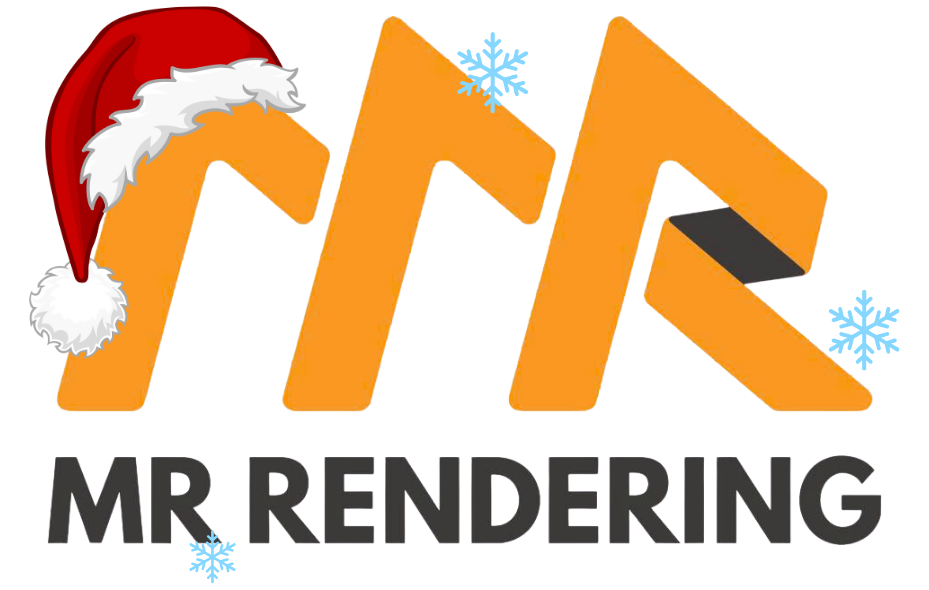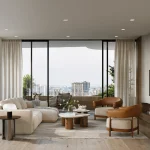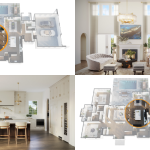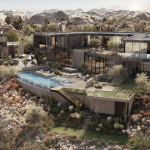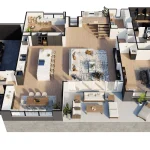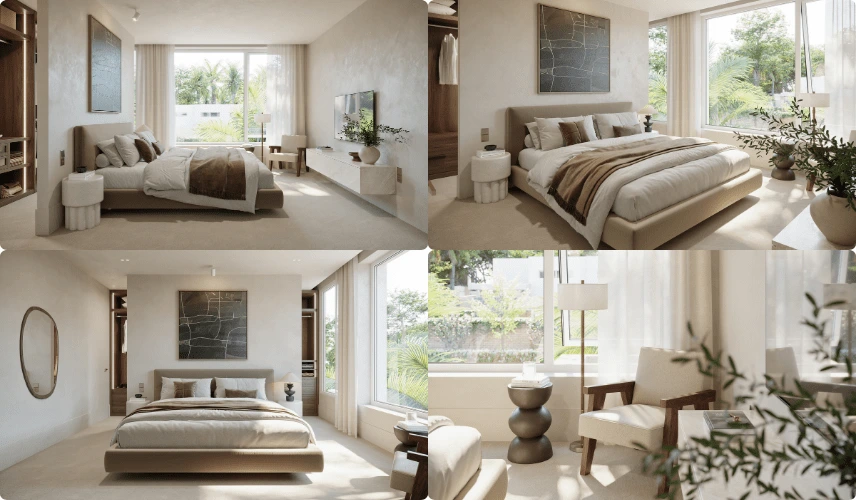
In the dynamic world of design and real estate, interior rendering has become a game-changer. Whether you’re a homeowner envisioning a dream renovation, an interior designer pitching bold concepts, a real estate broker showcasing off-plan properties, or a marketer crafting eye-catching campaigns, 3D visualizations bring spaces to life before a single nail is hammered. These photorealistic renders save time, prevent costly mistakes, and drive decisions with confidence.
But the burning question remains: How much does interior rendering cost? The answer isn’t a simple price tag- it’s a blend of factors tailored to your project’s needs. In this in-depth guide, we’ll break down the key elements that shape interior rendering cost, share insider tips to stretch your budget, and highlight why this investment pays off. By the end, you’ll know how to secure stunning 3D designs without breaking the bank.
Who would need interior rendering?
Interior rendering has become indispensable across industries, offering a virtual window into spaces that don’t yet exist. Whether you’re renovating a home, pitching a design, or marketing a property, 3D renders deliver unparalleled clarity and impact. Here’s who benefit most from interior rendering.
- Homeowners: Visualize renovations- such as a modernized kitchen or a cozy living room – before committing to costly changes. This helps avoid design missteps that could lead to expensive revisions.
- Interior Designers: Present polished, client-ready concepts that communicate ideas vividly, speeding up approvals and building trust.
- Real Estate Professionals: Showcase off-plan properties or virtually stage empty spaces, transforming blueprints into aspirational homes that attract buyers.
- Marketers: Craft compelling visuals for websites, brochures, social media, or ad campaigns, driving engagement and conversions.
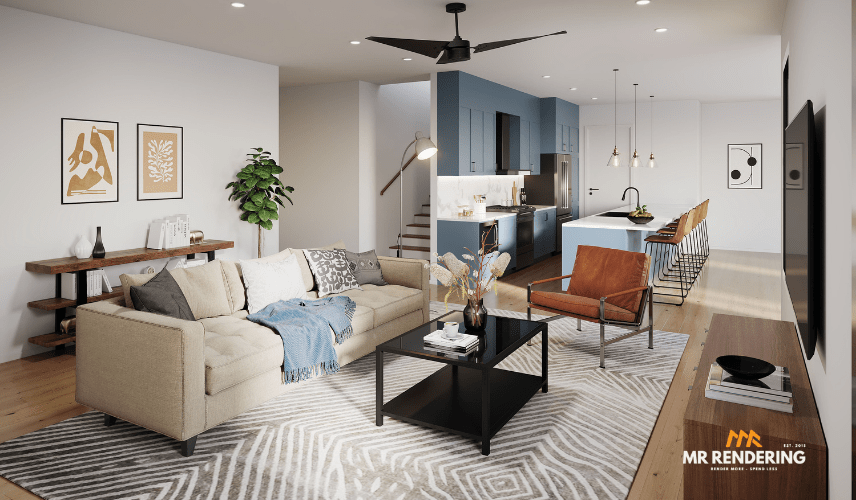
Modern Living Room 3D Interior Rendering Charlotte NC – Get More Here
Key factors that shape interior rendering cost
1. Project Complexity and Level of Detail
The complexity of your design is the primary driver of cost. A simple space, like a minimalist bedroom with basic furniture and standard lighting, requires less time and expertise to render, keeping costs on the lower end. In contrast, a high-end penthouse with intricate details – such as custom chandeliers, reflective marble surfaces, or lush greenery- demands advanced modeling and rendering techniques. Features like ray-traced reflections, volumetric lighting, or hyper-realistic textures can increase costs by 50-100% due to the computational power and skilled labor required.
2. Number of Views or Angles
The number of perspectives you need directly impacts the price. A single “hero shot” (e.g., a wide-angle view of a living room) is sufficient for internal reviews or small projects, keeping costs low. However, marketing campaigns or virtual tours often require multiple angles- close-ups of key features, wide shots of entire rooms, or 360-degree panoramas. Each additional view adds to the workload, increasing costs by 20-50%.

Panoramic renders, popular for immersive virtual tours, are particularly resource-intensive due to their wide field of view and high resolution. For instance, a single panoramic image might cost 30% more than a standard render. To optimize, decide upfront how many views are essential and whether alternatives like video walkthroughs might offer better value.
3. Resolution and Image Quality
The technical specifications of the final output play a significant role. Low-resolution renders (e.g., 1080p) are ideal for early drafts or internal feedback, costing less due to lower computational demands. High-resolution outputs (e.g., 4K or 8K) are necessary for print materials, large displays, or premium digital campaigns, but they require more processing power and time, driving up costs.
4. Turnaround Time
Deadlines significantly affect pricing. A standard rendering project typically takes 5-10 days, but urgent requests, such as for a time-sensitive marketing launch, can incur rush fees of 20-50%. Providers may need to allocate additional resources, such as overnight rendering or extra staff, to meet tight timelines. Planning ahead and allowing sufficient lead time can keep costs manageable.
5. Revisions and Collaboration
Most rendering quotes include 2-3 rounds of revisions, covering adjustments to lighting, furniture placement, or color schemes. However, extensive feedback loops or significant changes – such as redesigning an entire room layout – require re-rendering, which increases costs by 10-20% per round. Providing clear instructions upfront can also reduce costs. For instance, specifying “warm lighting with neutral tones” is more efficient than vague requests like “make it look nice,” which may lead to multiple iterations.
6. Experience and Expertise of the Provider
The skill level of the rendering team influences both quality and cost. Junior artists or freelancers may charge less but lack the polish of seasoned professionals. Specialized studios with expertise in architectural visualization or photorealistic rendering command higher rates but deliver superior results. For high-stakes projects, investing in experienced providers ensures visuals that align with your brand and goals.
Freelancer vs. Agency: Which Offers Better Value?
Your choice of provider significantly impacts interior rendering cost. Here’s how freelancers and agencies compare:
Freelancers
- Pros: Budget-friendly, direct communication, flexible workflows.
- Cons: Limited capacity, potential delays, inconsistent quality.
- Best for: Small, low-stakes projects like a single-room render for a homeowner.
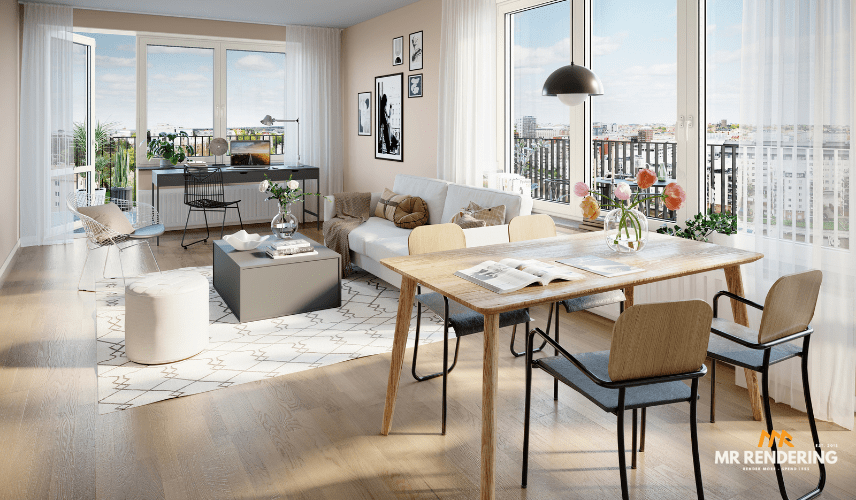
Read more projects about 3D Rendering ST Petersburg Florida
Agencies
- Pros: Scalable teams, reliable delivery, advanced services (e.g., cg animations, VR tours), and consistent quality.
- Cons: Higher costs, less personal contact.
- Best for: Large-scale or high-stakes projects, like real estate developments or marketing campaigns.
Offshore agencies, particularly in regions like Asia, often offer 20-40% savings compared to Western providers due to lower operational costs, without compromising quality.
Why Interior Rendering Is a Smart Investment
The cost of 3D interior rendering is not merely an expense – it’s a strategic investment with measurable benefits:
- Error Prevention: Identify design flaws, such as impractical layouts or poor lighting, before construction begins, saving thousands in rework costs.
- Faster Sales: According to 2025 real estate data, properties with virtual staging or 3D renders sell 20% faster and often at higher prices.
- Client Approvals: Designers using lifelike renders secure client sign-offs faster, reducing project timelines and boosting satisfaction.
- Marketing Impact: Marketers report up to 40% higher click-through rates and engagement when using rendered visuals in digital or print campaigns.
- Competitive Edge: In a crowded market, stunning 3D visuals differentiate your project, whether it’s a home renovation or a commercial development.
| Read a blog about 3D interior rendering services
6 Insider Tips to Save Big on Interior Rendering
Maximize your budget with these practical strategies:
- Define Your Scope Clearly: Specify rooms, views, and revisions upfront to avoid costly scope creep.
- Provide Detailed References: Share sketches, CAD files, or mood boards to reduce guesswork and revisions.
- Choose Realism Wisely: Opt for mid-tier quality if photorealism isn’t essential for your use case.
- Explore Pricing Models: Look for bundles or subscriptions to lower per-image costs.
- Select the Right Provider: Use freelancers for prototypes, agencies for high-stakes finals, and offshore studios for savings.
- Leverage AI Smartly: Use AI for early drafts to cut costs, reserving human expertise for final renders.
Maximizing Value with MR Rendering
For those seeking a balance of quality and affordability, consider a studio like MR Rendering, a Vietnam-based firm with over 30 artists specializing in architectural visualization since 2016. Here’s why they stand out:
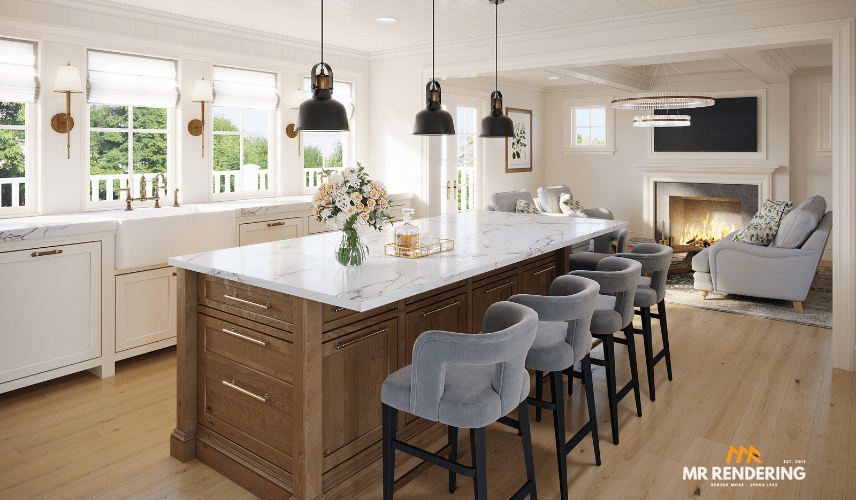
- Diverse Services: From static interior renders to animations, 360-degree panoramas, and VR tours, they cater to a wide range of needs.
- Competitive Pricing: Offshore operations enable rates up to 60% lower than US or European studios, with single renders starting as low as $200-$300.
- Scalability: Their large team handles multiple projects simultaneously, ensuring fast delivery even for complex orders.
- Global Advantage: Their “render while you sleep” model leverages time-zone differences, providing overnight turnarounds for clients in Western markets.
By partnering with a studio like MR Rendering, you can achieve high-quality results without the premium price tag, making it an ideal choice for both small and large-scale projects.
Conclusion
Interior rendering costs in 2025 depend on factors like project complexity, number of views, resolution, turnaround time, revisions, and the provider you choose. By understanding these variables and applying cost-saving strategies-like clear scoping, smart provider selection, and AI-assist- you can secure stunning 3D designs that deliver exceptional value.
Whether you’re a homeowner, designer, real estate professional, or marketer, 3D interior rendering is a powerful tool to bring your vision to life. Ready to get started? Connect with a professional studio like MR Rendering to estimate your project’s cost and create visuals that captivate, convert, and inspire.

Content Marketing Specialist
Linh Nguyen is a seasoned copywriter and marketing strategist with 15 years of experience in brand building, customer engagement, and cross-functional campaign management. For the past 5 years, she has specialised in the real estate industry, bringing in-depth knowledge of property marketing, buyer psychology, and market trends.
